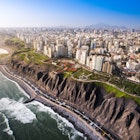

If you're traveling between districts in Lima, splurging on a taxi might be worth it © Guillermo Spelucin / Shutterstock
Notorious for its chaotic traffic, Lima is a sprawling metropolitan city that can be intimidating for newcomers to navigate.
Once you move past the shock of near-constant car horns and optional-at-best turn signals, getting around Lima can become a manageable adventure. Here's how to get around the Peruvian capital.

Take the scenic route on the city bus that's safest for visitors
One of the first observations a traveler will make about Lima's public transportation is the sheer variety of buses. Size, shape, color, model, and smoke emission are all variables here.
Considering the high accident rate and risk of pick-pockets, leave the small, usually white vans known as combis or colectivos to the locals. Slightly safer are the large, school-bus-sized buses, which come in myriad colors. They are painted with street names that signify their distinct routes.
Though bus stops throughout the city are marked (look for blue signs that read paradero), there is no set bus schedule, nor maps dictating the routes of these buses. In other words, you will constantly have to ask locals which bus to get on, when to get off, and how much to pay.
Given the confusion often caused by fares and schedules and the safety concerns for visitors on the older public buses, your best bet is to use the relatively new bus system, .
The four available routes stretch from Barranco to the easternmost district of Rimac and can be found on the website, along with designated bus stops. To board, wait in line and have your coins at the ready to pay the flat fee of S1.50 (US$0.40).
Unfortunately, the safer the bus system, the longer it takes to get from point A to point B. If you are in a hurry, take an alternative to the bus.

Hop between districts on the Metropolitano
Lima’s Metropolitano is a rapid-transit system that links 12 districts, including the more touristy neighborhoods.
The first of its kind in Peru, the metro is a fleet of bi-articulated buses that run along the Paseo de la Republica expressway in its own designated lane – a great option for those based in districts such as Barranco or Miraflores who want to get to the historic center.
Before you board, you'll need to purchase a rechargeable card (S5/$1.40) from any metro station, and then load it with credit. The fare is set at S2.50 ($0.69), no matter the route. You have to pay with cash. Once you've loaded credit onto your card, simply swipe it at the turnstile and continue to your platform.
Like subway stations, passengers await the bus at elevated platforms, and each station has a customer information booth. Check out the metro's comprehensive for details on lines and stations.

Splurge on a taxi once in a while
Taxi is by far the most expensive way to get around Lima but it can be good for traveling between districts. There are a lot of unlicensed taxis in the city. Official cabs should have a rectangular authorization sticker with the word SETAME on the upper left corner of the windshield. They may have yellow paint, too.
Lima’s taxis don't have meters, so always negotiate a fare before getting in. Better still, opt for a rideshare app like Uber or Cabify. Undesignated and private taxis tend to increase their fares for tourists.

Explore on foot along the malécon
As the second-largest desert capital in the world after Cairo, Lima doesn’t sound pedestrian-friendly. However, travelers tend to only visit a handful of districts that neighbor one another, which are linked by the scenic coastal pathway known as the malecón.
From Surquillo, home to Lima’s best food markets, to touristy Miraflores takes minutes on foot. After shopping or grabbing a bite to eat, enjoy a 20-minute walk to Barranco for amazing museums, galleries, and boutique cafes.
Looking to laze away the afternoon in a slightly more natural setting? Bike, jog, or walk along the malecĂłn until you find the grassy patch with your name on it.
Stretching from Barranco to the edge of San Isidro with Magdalena del Mar, the malecĂłn makes hopping between popular Lima neighborhoods a breeze.
Along the malecón, municipalities have started to roll out fleets of bikes for rent. It’s a big step for a city that is still lightyears behind when it comes to cycling. Official bike lanes beyond the coastal path are few and far between, and cyclists should take caution when pedaling near heavy traffic.
Accessible travel in Lima
As the capital of Peru, Lima has a long way to go for inclusive access and conveniences for travelers who are hard of hearing or vision-impaired. The latest shopping centers have elevators, but sidewalks can be narrow or busy, and Braille signs are absent for the visually impaired.
The only public transportation with wheelchair access is the Metropolitano – nearly all the stations have elevators to the platforms, and designated spaces for wheelchairs aboard the bi-articulated buses are clearly marked.
By law, and as clearly stated at each metro station, passengers are obliged to give preferential access to those who are disabled.
For more information, check out Ďă¸ŰÁůşĎ˛ĘĽ´Ę±żŞ˝±â€™s .
Explore related stories



 Budget TravelLove Lima for less: how to stretch your budget in the Peruvian capital
Budget TravelLove Lima for less: how to stretch your budget in the Peruvian capitalDec 12, 2023 • 5 min read







